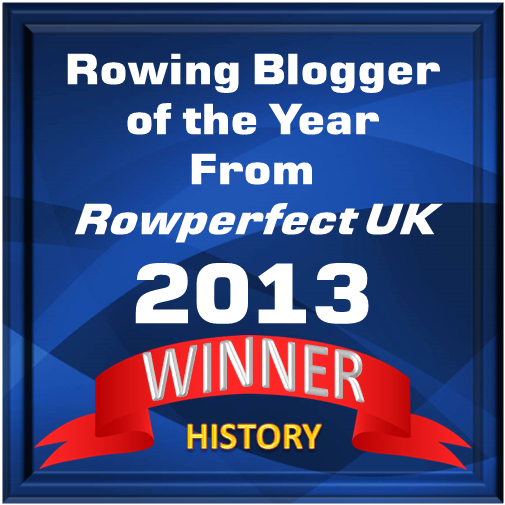 The Cambridge crew which met Harvard in a race on the River Thames on 8 September, 1906. Standing, from the left: A.B. Close-Brooks, H.G. Baynes, and H. Shimwell (substitute); seated: M. Donaldson, B.C. Johnstone, F.J. Escombe (coach), H.M. Goldsmith, D.C.R. Stuart, and G.H.F. Benham; seated in front: B.G.A. Scott and R.V. Powell.
The Cambridge crew which met Harvard in a race on the River Thames on 8 September, 1906. Standing, from the left: A.B. Close-Brooks, H.G. Baynes, and H. Shimwell (substitute); seated: M. Donaldson, B.C. Johnstone, F.J. Escombe (coach), H.M. Goldsmith, D.C.R. Stuart, and G.H.F. Benham; seated in front: B.G.A. Scott and R.V. Powell.The first international rowing competition between an English and American university was in 1869, when Harvard travelled to meet Oxford in a coxed four race on the championship course on the River Thames in London. The Atlantic cable had just opened so the American newspapers quickly received the reports about the crews training and, on the 27th of August, the race report. Rowing historian Bill Miller has written an article about the race, "The Great International Boat Race".
It would take another 37 years before another international race between an American and an English university would take place.
 On 2 May, HTBS’s Tim Koch reported on the mishap he had found on Wikipedia about the English oarsman Eric Powell, who was a Cambridge Blue in 1906, 1907, and 1908. The first year Eric rowed for Cambridge, his two-year older brother, Ronald Powell (seen on the right), was also in the boat. Ronald had rowed in two previous light blue crews, in the winning 1904 crew and the losing 1905 crew. In 1906, the Cambridge boat was victorious again.
On 2 May, HTBS’s Tim Koch reported on the mishap he had found on Wikipedia about the English oarsman Eric Powell, who was a Cambridge Blue in 1906, 1907, and 1908. The first year Eric rowed for Cambridge, his two-year older brother, Ronald Powell (seen on the right), was also in the boat. Ronald had rowed in two previous light blue crews, in the winning 1904 crew and the losing 1905 crew. In 1906, the Cambridge boat was victorious again.On 28 June that year Harvard won against Yale in a downstream race on Thames River in New London. Harvard was eager to match oarpower with the winner of the Oxford-Cambridge race, so without further delay, a ‘cable’ was sent to Francis Lee Higginson, an Harvard man, who had taken up an English summer house close to Bourne End, the residence of the famous English coach Rudy Lehmann. Higginson and Lehmann knew each other well, as Higginson had rowed for Harvard in 1898 when Lehmann was over in America, coaching the Harvard crew. On 15 July, 1906, Higginson looked up Lehmann to show him the message in which Harvard was challenging Cambridge for a match on the Thames in London. The Harvard crew stood ready to leave America as soon as the challenge had been accepted by Cambridge.
In his book The Complete Oarsman (1908), Rudy Lehmann writes that he hesitated as he was not sure that a representative Cambridge crew could be brought together as the crew has scattered all over after Henley. After consulting with Raymond Etherington-Smith and Claude Goldie, Lehmann decided to approach old Cambridge men to raise funds for several weeks of training. The subscription list eventually showed a total of £356 15s. Lehmann and Henry Goldsmith, the Cambridge Boat Club president, also sent letters and telegrams to get the Cambridge crew together. At a meeting in London, a date was set for the race, 8 September, and as soon as a representative crew was pulled together H.M. Goldsmith, selected the coaches. His choices fell on Francis Escombe and Stanley Muttlebury.
While Ronald Powell was able to train and row in the Cambridge boat, his brother Eric was, as C.M. Pitman writes in his The Record of the University Boat race 1829-1909 (1909) “unable to return from the Continent”. In total, the Englishmen took in two substitutes in their boat, so when it was time for their first practice outing on 6 August at Bourne End, the Cambridge crew looked like this:
A.B. Close-Brooks, bow
J.H.F. Benham, 2-seat
H.M. Goldsmith, 3-seat
M. Donalson, 4-seat
H.G. Baynes, 5-seat
R.V. Powell, 6-seat
B.C. Johnston, 7-seat
D.C.R. Stuart, stroke
B.G.A. Scott, cox
The Americans arrived in England on 4 August, and two days later, they were also practicing at Bourne End. The Harvard crew looked like this:
R.M. Tappen, bow
S.W. Fish, 2-seat
R.W. Flint, 3-seat
C. Morgan, 4-seat
J. Richardson, 5-seat
R.L. Bacon, 6-seat
D.A. Newhall, 7-seat
O.D. Filley, stroke
M.B. Blagden, cox
Pitman reports that due to illness, the Harvard crew had to make several changes during their training. Regarding their boat and style, he writes, “They row in a centre-seated boat, and used swivel rowlocks and very long slides. Their general style was very much like that of other American crews which have visited this country, a style which appears to the English critic to result in an almost complete sacrifice of swing to leg work.”
“Cambridge v. Harvard 1906” continues tomorrow!









.jpg)
+Cambridge+Boat+of+2013..JPG)
)

No comments:
Post a Comment